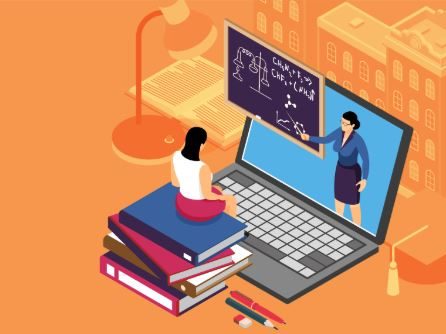Having summarised the lockdown learning dilemma we are experiencing now, my attention turned to the DfE’s “tech giants” and EdTech Demonstrators Programme what tomorrow may look like. So part II of Learning in lockdown so to speak.
Whilst I am a edtech enthusiast, I do not see a post-lockdown edtech revolution. “Two years growth in two months,” CEO Satya Nadella is phenomenal, however this heighten digital connectivity is the solution to the requirements of the lockdown restrictions, in the absence of in-person meetings. It has also raised the profile and opportunity of collaborative working. This powerful, almost enforced, experience and exposure will have a legacy, however it will not become default nor will it always be preferential? I foresee tomorrow as an opportunity to iterate and innovate on the practice of these two key areas: remote (video conferencing) and collaborative, asynchronous and synchronous working practice. Just behind these two chronologically, is cloud-assisted working (live feedback about your work, translation, search, explore) and greater adoption of voice.
Maintain momentum
The government announced a support package, that guidance will “walk schools through the key assets of both Google and Microsoft’s platforms” and provide an option to register for Government-funded expert support in getting either G Suite for Education or Office 365 Education. That is good news for edtech – is it money well spent? How will remote and collaborative workflow practice benefit education, benefit teaching, learners now and tomorrow? (I few ideas for teachers here – Faster feedback – more with less.)
Now: Education, business, everyone, is exploring the opportunities of “remote” connections, meetings and of course learning. We are witnessing some innovative use of recorded content (ResearchEd-loom) and live meetings and livestream broadcasting – here’s ResearchEDHome with Dylan Wiliam and The Show Must Go Online. 🎓 IMHO, our country has been enriched by the availability of some wonderful cultural content, Frankenstein was stunning. But what of tomorrow?
Tomorrow: When the tide changes – remote will still be a familiar reference point. There will be more willingness, awareness and acceptance of all things remote, “remote ___________.” Remote meetings, conferences, training, performances, learning and teaching. There will be an gradual increase in collaboration, just much more gradually, as this requires both a change in thinking and action. An even slower adoption of workflow automation – as this needs an even more precious commodity – trust.
Remote teaching however will service only a proportionally small number of learners, in specific circumstances. Or for those learners “not in school” home-school learners, virtual school learners, professional athletes / actors, medical absence, small independent schools broadening their curriculum offer by connecting across a group of schools, typically for A Level where small groups are more common. For additional schooling or tutoring, or learning over geographically dislocated learners, accessing very specific, possibly global education programmes. Lastly, truly remote learners, adult learners, incarcerated learners and those learning for pleasure.
Live streamed and recorded events will be more common offering a whole host of opportunities. Allowing for schools to come locally, nationally and internationally – to attend “__________.”
Tomorrow: In summary however, for the majority, remote and collaborative opportunities will primarily service improved blended and distance learning opportunities and the breadth of content and connection. I foresee little else changing for most school leaders and even less for most teachers.
‘Unleash remote learning’
The tech giants have offered their service. Now, unleash remote learning – to 93% of families connected to the internet, minus those without hardware, with consideration to those that need support accessing their learning, (special educational needs or language barriers) and those not yet ready to self direct their online or remote learning experience. Some schools were more prepared than others, all school setting better suited the adoption of remote or distance / blended learning and collaboration.
Remote: The use of video conferencing in place face-to-face teaching.
Blended: Face-to-face teaching and distance learning.
Distance: Only online learning.
Collaboration: Synchronous (editing a document simultaneously) and asynchronous (editing a document(s) at different times) working.
Here is the scenario, strategically the decision has been made. This imaginary school has gone with Google’s G Suite. Tactically, all learning is being delivered via Google’s G Suite. Operationally, as a teacher, you are to unleash remote learning. A situation many teachers around the world are facing.
I am reporting on Google’s G Suite as I have a unique perspective. As a parent, as a teacher/parent supporting my son at home, with live feedback from my son. As a teacher building a course and piloting a remote course. My observations are specific to our context, however, a lot of what I am about to report applies to distance learning with Office 356, Moodle, Canvas…
What’s my beef
I have a beef with the phrase “Getting started with” or “101.” These phrases imply you begin at the start – “create class”. No debate, the start is the wrong place to begin! At every level – strategically, tactically, operationally. But especially for teachers are the coal face.
As a teacher / course designer, getting started, at the start line, progressing forward is potentially disastrous. Stop.
As a teacher, you would not start teaching without a curriculum and learning aims or before defining the culture and climate of the classroom, before modelling how ‘we’ will work together. Apply the same thinking, planning and design here.
It is very easy, very tempting, rewarding even, to create learning assets and build a course, without fully understanding what the delivery model has to offer, without ever seeing a completed course or taking a distance / blended learning class. Where courses very quickly become overgrown repositories and the learning pathways confused or muddle. What is more, building learning assets in Google Classroom is so easy (a strength of the product) it intuitively encourages a build and get started approach, 🤦♂️ without ever considering how learners interact with the course, with one another, or how these learner interactions, responses, assignments and feedback, may be use, re-used or employed to the benefit of the learning experience. Sadly, this can all to easily led to learners “retiring,” or disengaging from the course. And just as with traditional learning, getting this learners back on track is difficult, IMHO it is almost impossible at a distance or in blended learning class settings.
Let’s not forget that learners have moved away from the relatively stable, directed, familiar learning environment of a classroom, to a less familiar, guided, more individualised learning environment, with collaborative opportunities – with or without the support or space / dining room table to learn. For a few that is better than school, for most, they will need support with the transition. With all that in mind, let’s take a look at Google Classroom G Suite (or a fully integrate cloud solution) as the delivery model. Instructional models for blended / distance / remote learning will have to wait. As will thinking through the opportunities presented by collaborative working, both synchronously and asynchronously.
Let’s get back to that word “suite.” One the greatest strengths of Google’s Education product response IMHO is that word “suite.” A suite of tools that support, integrate and complement each other – across devices and form factors. (To what extent does it integrate with other products? A research task for me).
What is G Suite – Office productivity tools (Docs, Sheets and Slides, Forms, Drawing). Drive storage. Collaboration (Asynchronous and synchronous). Calendaring. Classroom. Communicate – email, chat, and video conference.
Plus, it is Google, so there are other education goodies; Keep, Google Play Books, Sites, Translate, Google Expeditions, connecting to other Google products eg Youtube, Earth. Lastly I expect to see more from speech-to functionality.
There is a whole ecosystem around the Chrome browser and another steep learning curve around Chromebooks and the Chrome OS.
It is not these individual tools that makes it work for our son, but, again, that they all seamlessly support, integrate and complement each other – across devices and form factors. From the moment our son receives his notification via the Google Classroom App, to reading the task, opening a document to writing his response, submitting the assignment, to receiving his feedback or grade – seeking private support from his teacher, or connecting / helping his peers in Class Comments, he never leaves the Google Classroom, from within the G Suite, browsing in Chrome. End-to-end within the Google ecosystem.
Now I am currently working in a Google Personal Account. Within the G Suite for Education there are “Guardian” summaries. When educators turn this on for a class, guardians receive automatically generated summary emails detailing learner progress, daily or weekly. Google has really keep connection and communication at the forefront of the learning experience.
Verdict
I have been quietly impressed with the G Suite for Education and Google Classroom (though still need to get my eyes on an admin panel) for these key reasons (sitting below the key strategic considerations).
- G Suite has a low access threshold: Connectivity. Any device, any form. Google Classroom is one product within of G Suite.
- Learner workflow (including submitting, assessment and feedback) is an end-to-end experience protected within the Google ecosystem. Available across devices, in the browser and app.
- Google Classroom functionality is modest, simple (used positively) and therefore the staff / learner and parent / carer) training is low.
- Google Classroom communication is effective and presented on-screen in close proximity to the actual learning it refers to.
- Google Classroom is a communication partnership of learner-teacher- parent.
- Collaboration happens by proximity – teachers and learning will need support.
Given the fact that getting started is relatively easy, courses are simple to construct – do not start at the beginning. Start with the end in mind.
In other news, I completed my Distance Learning for Educator course.




Pingback: Plans, cycles and spirals (part 2) | KristianStill